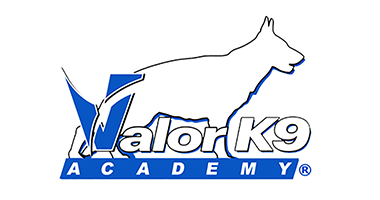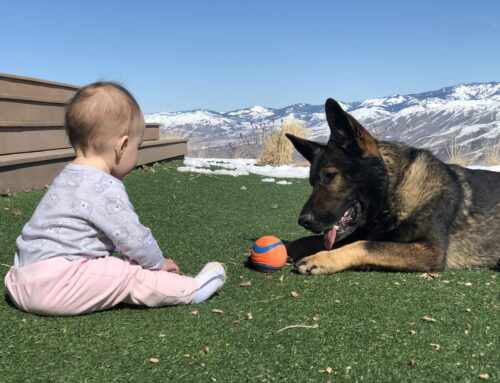When I was first got started as a dog trainer, I knew very little about nutrition. I gave my dogs Taste of the Wild dog food and didn’t think twice about it. Then I attended a canine nutrition seminar in Chattanooga that was hosted by a holistic veterinarian. That’s where I learned more about the cooking process of kibble and the other, healthier options available for my dogs. At the time, living out of an apartment with limited freezer space, and an even more limited budget, I couldn’t feed raw. So I opted for the second best option, freeze-dried food, and I fed my dogs Grandma Lucy’s. I did that for years, using kibble as a training reward. Then I started adding raw toppers, and now I feed a fully balanced and fresh raw diet to my dogs. Here’s how I do it.
70/10/10/10 +V/S
I follow the most basic plan out there. It’s normally called 80/10/10, but for the sake of this post I’m going to break it down even more so it more accurately matches exactly what I do. So I’m calling it “70/10/10/10 +V/S” and what it means is that I feed the following:
- 70 percent muscle meat
- 10 percent organs
- 10 percent bone
- 10 percent vegetables and fruits
- + Vitamins and Supplements
70 Percent Muscle Meat
When I feed meat, I source my protein from the grocery store 90 percent of the time. Sometimes I go to a butcher, and sometimes we have scraps and leftovers from hunting. But the majority of the time I buy my dogs’ food at the store when I go grocery shopping for the family. I stick to a few main proteins and feed in this order (from most to least):
- Beef
- Chicken
- Fish
- Pork
- Elk
- Deer
I look for meat that’s $2 or less. For beef, this means beef heart, ground beef and any beef that’s on sale (even if it’s up to $3 a pound).
For chicken, this means chicken quarters (usually $1/pound or less), chicken wings and drumsticks, eggs from our chickens, and sometimes chicken breast if it’s on sale.
For fish, we feed our dogs fish from our fishing trips and canned fish from the store (usually Jack Mackerel, which I believe is $2 or $3 a can. Not cheap, but worth it). Fish is a great source of Omegas for dogs!
Pork is anything that’s $2 a pound or less.
Elk and deer are seasonal scraps and carcasses from our kills, and any freezer burnt or older meat from our big chest freezer. (Justin and I both hunt, and we try to fill our tags each year, so that means lots of meat for the family, and the dogs!)
I also include fats in this category. I buy beef fat any chance I get and throw a few pieces in with my dogs’ food. Fat is very, very good for dogs and it’s found naturally on lots of meat out there.

10 Percent Organs
Dogs get a ton of nutrients from organs. Google it, you’ll be amazed! I primarily feed secreting organs like liver, and usually it’s beef liver or chicken liver, since it’s available at the grocery store for a reasonable price. I also feed chicken hearts and gizzards but not often. And I have a supplement pill for pancreas that I give my dogs. Sometimes the organs account for up to 20 percent of the meal.
Pound for pound, organs are much more nutritious than muscle meat. It’s why wild carnivores eat organs first. But don’t go overboard. Too much of a good thing is not good.
10 Percent Bone
Dogs need bone. It provides nutrients, and it firms up their stool. Any muscle meat that already has bones in it (raw and uncooked) count towards this 10 percent. Chicken quarters, for example, or elk carcass. But I also like to give my dogs bones separately as a nice chew to clean their teeth. I especially like Beef marrow bones. They’re not cheap, but, compared to other bones you’d buy for your dog, they’re reasonably priced.
They usually get one or two marrow bones each week (every 3-4 days or so). I also give soup bones and chicken paws.
Never give smoked or cooked bones to dogs.
10 Percent Vegetables and Fruits
Dogs love vegetables and fruits if they’re introduced to them as puppies and fed to them on a regular basis. But even so, for some I like to “sweeten the deal” and I cook them in broth so they have more of a broth flavor to them as opposed to a veggie or fruit taste. Any dog-safe veggies and fruits are fine to give dogs (including garlic, in some amounts). Primarily I feed:
- Broccoli
- Carrots
- Cooked Sweet Potatoes
- Green Beans
- Canned Pumpkin
- Spinach
- Tomatoes
- Garlic
- Berries (Blueberries, Raspberries, Blackberries)
- Strawberries
- Pineapple
- Peeled Oranges
- Peeled Bananas
I don’t feed many if any starches like rice and corn. Dogs don’t digest carbs well, so I stick to fruits and vegetables for this category. But if a dog is thin and I’m trying to put weight on him, I’ll feed extra cooked sweet potatoes and canned pumpkin. Corn husks are dangerous for dogs; never give them to your dog. Seeds from fruits and onions are also toxic.
Cooked vegetables and fruits do digest better for dogs and it gives them optimal nutrition, but I don’t always have time for it. I just pop an extra thing or two into their bowl and call it good. But when I can cook, or if I’m cleaning out the produce in the fridge, I put some broth in their and cook on low heat, and they love it! I also give them the pulp from any juicing I do. I mix a small amount into their bowl, usually with some egg, and they eat it right up!
+ V/S
Vitamins and Supplements are not necessary if your dog’s food always has all the nutrients he needs, but we oftentimes don’t give them a perfectly nutrient-rich meal. So I supplement. This is one you’ll want to research, because your dog’s age, breed, weight and overall size will affect what to give, when, and how much. But for my now-adult dogs, I always give them:
- NuVet Labs Multivitamins
- NuVet Labs Joint Vitamins
- Vitamin E
- Vitamin C
- Green Lipped Mussels
- Krill Oil
- Salmon Oil
- Collagen
- Beet Powder
- Nonflavored Greek Yogurt
- Kefir
- Goats Milk
I don’t give all of them every meal. I usually give the NuVet Labs ones daily, and then the others 2-3 times a week. Again, it’s based on their age, breed and weight, so not every dog is the same.
If you’d like to look at NuVet Labs, go to their website. I get the green bottle and the blue bottle. Use my code “45459” at checkout and I’ll get a small kickback, thanks!
I also give my senior dogs CBD. The health benefits are unbelievable. And it’s stopped Zoey from having any more seizures!
Here’s another example dinner for my dogs:

When I Feed My Dogs
I feed one meal a day: dinner. And it’s always 2 hours or more after activity has ceased. I put all their food in a bowl, mix it up a little, and give it to them. They’re always in a down/stay while Emma (my daughter) and I prep their food, and they must wait until I say “OK” to eat. Emma is never walking around while they eat; she’s always up on the chest freezer watching from above until they’re done eating.
One meal a day for dogs is better than two meals a day, but there are arguments on both sides of this debate. I choose to feed once a day.
That said, I do use kibble (Farmina N&D Ancestral Grain Lamb and Fish) as a training reward. I do try to give them their training reward and meal within the same eight hour period. They never get more than maybe a cup of kibble total during training (each), and it’s never followed by activity.
If you aren’t familiar with bloat (GDV), and if you have a large and/or deep-chested dog, look it up. It can be deadly.
How I Balance Their Meals
I don’t balance my dogs’ meals every day. They don’t always get a perfect 70/10/10/10 meal. I don’t ever weigh their food. But you can, and there are charts out there that tell you how many ounces or pounds of food to give your dog. I’ve been doing this for so long, and I know my dogs’ activity levels so well, that I just eyeball it at this point. I balance their meals out over about a week’s time. That’s what works for me. It has for years.
And every year, their bloodwork comes back awesome. The vets are always impressed with how balanced it is. I study the results carefully and if something is a little bit low or a little bit high, I make the necessary adjustments.
For example, Zoey’s potassium was within the Normal range, but on the low end of it, so I give her banana a little more often. Doing annual blood work is an absolute must.
You can also consult a certified canine nutritionist for help with creating meals.
This is what I do. It works for me and my dogs (one Australian Shepherd and four German Shepherds). And I continue to keep up on research as far as changes in food ingredients in kibble, new research on effects of different vitamins and minerals, etc.
But I am not a scientist. That’s kind of the point. You don’t have to be an expert to feed your dog raw. You don’t need a degree. You just need to apply yourself and decide to do it. Even if you just add a little bit of meat and some V/S to your dog’s food, that’s better than a strictly kibble diet.
Also worth mentioning, I feed whole chickens to my dogs. Old hens and mean roosters that I cull. I dispatch them, freeze them, thaw them a little, and then feed them to my dogs. They eat the whole thing and even some of the feathers. Whatever feathers the adult dogs leave behind, the puppies gladly eat! This is an excellent way to provide everything a dog needs. Interestingly enough, and something that says a lot about dogs, when eating a whole animal, they will eat first whatever their bodies need most. Most of the time, they go for the organs. After that, the brains.
More Resources
This blog is just the start. There’s so much information on there on feeding raw. It’s fascinating to learn about it and might even get you to start thinking more carefully about what you put into your mouth. (You are what you eat, after all!) I highly recommend Canine Nutrigenomics the book and the group Raw Feeding University on Facebook.
And like I said, there are canine nutritionists who can help you formulate a meal plan just for your dog! Carmavore Nutrition is one of them. Kelsey knows her stuff!
To learn more about CBD click here.
I hope this helps some of you who read it. I tried to keep things simple and straightforward. Comments are always welcomed and answered.
Amy Pishner
-Owner/Head Trainer, Valor K9 Academy





Leave A Comment